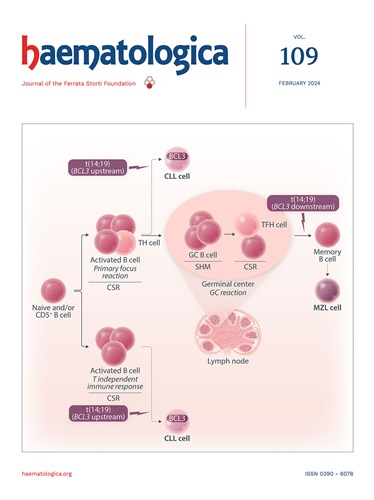Intensified conditioning with high-dose total marrow irradiation and myeloablative chemotherapy reduces risk of relapse without increasing toxicity in allogeneic hematopoietic stem cell transplant for high-risk myeloid malignancies: a phase II study.
IF 7.9
1区 医学
Q1 HEMATOLOGY
引用次数: 0
Abstract
The intensity of the conditioning regimen in hematopoietic stem cell transplantation (HSCT) correlates with the risk of relapse, however its potential benefit may be outweighed by the associated risk of toxicity. The addition of total marrow irradiation (TMI) to myeloablative conditioning provides an opportunity to increase intensity with minimal additional toxicity. In this phase 2 clinical trial, 30 patients with high-risk myeloid malignancies received an allogeneic HSCT using myeloablative TMI at 9Gy in combination with standard myeloablative fludarabine/intravenous busulfan (FluBu4) chemotherapy. The study included patients with matched-related donors (n=10) receiving TMI/FluBu4 and patients with matched unrelated (n=14) or 1-antigen mismatched unrelated (n=6) donors receiving TMI/FluBu4 and rabbit antithymocyte globulin. All patients achieved sustained engraftment. Grade 3-4 extramedullary toxicities were: mucositis in 59% (n=17), nausea/vomiting in 10% (n=3) and diarrhea in 7% (n=2) of the patients. Acute graft-versus-host disease (GVHD) grade III-IV was seen in 4 patients (13.3%). Moderate/severe chronic GVHD was observed in 11 patients (36.7%). With a median follow-up of 1483 days (range: 63-2260 days) for patients alive, the overall survival and disease-free survival at 1 year were 72.4% and 65.5%, respectively. GVHD-Free Relapse-Free Survival at 1-year was 41.4%. Of 30 patients in the study, 6 relapsed/progressed (20%) and 5 of them died of the disease (16.7%); whereas 6 patients (20%) died of transplant-related mortality. We conclude that a myeloablative regimen with TMI at 9Gy and FluBu4 was well tolerated and achieved encouraging results in patients with myeloid malignancies at high risk of relapse (clinicaltrials.gov Identifier: NCT03121014).一项II期研究:高剂量全骨髓照射和清髓化疗强化调理可降低高风险髓系恶性肿瘤同种异体造血干细胞移植的复发风险,同时不增加毒性。
造血干细胞移植(HSCT)中调节方案的强度与复发风险相关,但其潜在的益处可能被相关的毒性风险所抵消。骨髓全照射(TMI)的加入为骨髓清除条件提供了一个机会,以最小的额外毒性增加强度。在这项2期临床试验中,30例高风险髓系恶性肿瘤患者接受了同种异体造血干细胞移植,使用9Gy的清髓性TMI联合标准清髓性氟达拉滨/静脉注射布硫凡(FluBu4)化疗。该研究包括接受TMI/FluBu4的匹配相关供体患者(n=10)和接受TMI/FluBu4和兔抗胸腺细胞球蛋白的匹配非相关供体患者(n=14)或1抗原错配非相关供体患者(n=6)。所有患者均实现了持续植皮。3-4级髓外毒性为:59% (n=17)的患者出现粘膜炎,10% (n=3)的患者出现恶心/呕吐,7% (n=2)的患者出现腹泻。急性移植物抗宿主病(GVHD) III-IV级4例(13.3%)。中重度慢性GVHD患者11例(36.7%)。存活患者中位随访1483天(范围63-2260天),1年总生存率和无病生存率分别为72.4%和65.5%。1年无gvhd复发生存率为41.4%。30例患者中,6例复发/进展(20%),5例死亡(16.7%);而6例(20%)患者死于移植相关死亡。我们得出结论,9Gy的TMI和FluBu4的清髓方案耐受性良好,并且在复发风险高的髓系恶性肿瘤患者中取得了令人鼓舞的结果(临床试验。gov Identifier: NCT03121014)。
本文章由计算机程序翻译,如有差异,请以英文原文为准。
求助全文
约1分钟内获得全文
求助全文
来源期刊

Haematologica
医学-血液学
CiteScore
14.10
自引率
2.00%
发文量
349
审稿时长
3-6 weeks
期刊介绍:
Haematologica is a journal that publishes articles within the broad field of hematology. It reports on novel findings in basic, clinical, and translational research.
Scope:
The scope of the journal includes reporting novel research results that:
Have a significant impact on understanding normal hematology or the development of hematological diseases.
Are likely to bring important changes to the diagnosis or treatment of hematological diseases.
 求助内容:
求助内容: 应助结果提醒方式:
应助结果提醒方式:


